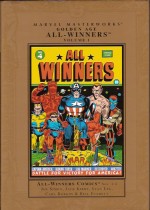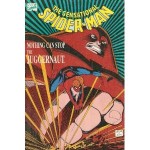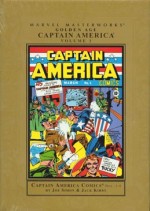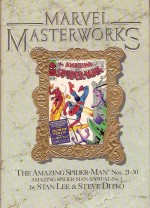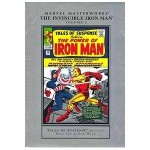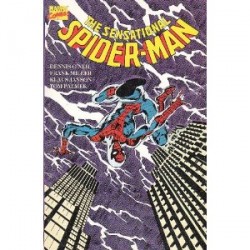
By Roy Thomas, Archie Goodwin, Steve Englehart, Herb Trimpe, John Severin & various (Marvel)
ISBN: 978-1-7851-2193-5
By the close of the 1960s the Incredible Hulk had settled into a comfortable niche and satisfyingly effective formula as the tragic Bruce Banner sought cures for his gamma-transformative curse, alternately aided or hunted by prospective father-in-law US General “Thunderbolt†Ross and a variety of guest-star heroes and villains.
Herb Trimpe made the character his own, the “house†Jack Kirby-based art-style quickly evolving into often startlingly abstract mannerism, augmented by an unmatched facility for drawing technology and especially honking great ordnance and vehicles – all of which looks especially great in the crisp black and white of these magically affordable Essentials volumes. And of course no one can deny the cathartic reader-release of a great big “Hulk Smash!†moment…
This chronologically complete monochrome treat contains issues #143-170, spanning September 1971 – December 1973, and opens with an inevitable but long-delayed clash as the Jade Juggernaut battled Doctor Doom in the Roy Thomas, Dick Ayers & John Severin epics wherein the hunted Bruce Banner found ‘Sanctuary!’ in the New York Latverian Embassy. The deal was a bad one as the Iron Dictator proceeded to enslave the Gamma scientist for his bomb-making knowledge in an attempt to make his awesome alter ego into an unstoppable war machine…
The scheme went awry in ‘The Monster and the Madman!’ (Thomas, Gary Friedrich, Ayers & Severin) as the brainwashed Banner broke free of his conditioning thanks to Doom’s conflicted consort Valeria just in time for the Hulk to deliver a salutary lesson in mayhem throughout the dictator’s domain.
Incredible Hulk #145 found the monster invading a film-set in Egypt and accidentally awakening a prehistoric alien war-weapon in ‘Godspawn’, by Thomas, Len Wein, Herb Trimpe & Severin, whilst in America the military, in the form of Thunderbolt Ross, opened a dedicated anti-Hulk base named “Project Greenskin†after which Gerry Conway scripted Thomas’ plot for ‘And the Measure of a Man is… Death!’ wherein the Hulk faced sandstorms, bitter memories and the Israeli army in the deserts of Northern Egypt whilst in America the Hulkbuster base was already being infiltrated by android facsimiles constructed by the Jade Giant’s greatest foe.
As the Hulk headed instinctively homeward the infiltration threatened the US President himself and led to a catastrophic clash between Old Greenskin and The Leader as well as ‘The End of Doc Samson!’. That issue (#147) also included a moving and powerful vignette ‘Heaven is a Very Small Place!’ wherein Thomas, Trimpe & Severin took the tormented titan to the very edge of paradise before horrifying reality once more reasserted itself…
Archie Goodwin debuted as scripter – with a little plotting assistance from a very junior Chris Claremont – in ‘But Tomorrow… the Sun Shall Die!’ as the monster’s lost love Jarella travelled to Earth and a longed for reunion just as Banner was apparently cured of his curse by radical solar-energy experimentation. Unfortunately, the princess from the micro-verse accidentally brought with her a super-assassin determined to end her life at all costs and somehow triggered the sun into going nova…
Forced to become the monster once again to save his beloved, the Hulk was captured by Ross’s forces only to escape when an ancient threat returned to Earth in #149, hungry for radiation to survive in ‘… And Who Shall Claim This Earth His Own? The Inheritor!’
After dispatching that threat the Gamma Goliath wandered into the wilderness where he encountered on-sabbatical X-Man Alec Summers who had banished himself – with girlfriend Lorna Dane – to the deserts of New Mexico, terrified of his uncontrollable cosmic power in ‘Cry Hulk, Cry Havok!’ (#150 April 1972).
When Lorna encountered a menacing biker gang and an Emerald Giant violently protective of his privacy, Summers finally proved himself against the rampaging but easily distracted titan…
‘When Monsters Meet!’ pitted the Hulk against a radioactive horror resulting from a disastrous cancer-cure derived from Banner’s blood after which Friedrich, Ayers & Frank Giacoia asked ‘But Who Will Judge the Hulk?’ as the helpless Bruce Banner was sent to trial for the destruction wrought by his emerald alter ego: a guest-star studded two-parter which concluded in #153 ‘My World, My Jury!’ with additional art from Trimpe & Severin.
After explosively escaping the kangaroo court, the fugitive fury discovered ‘Hell is a Very Small Hulk!’ (Goodwin, Trimpe & Severin) when he swallowed a defective shrinking formula, created by the Astonishing Ant-Man, in a forlorn attempt to rejoin Jarella in her subatomic world. Snatched up by the face-shifting Chameleon and the assembled hordes of Hydra, the diminished brute still managed to quash their treasonous schemes – at the apparent cost of his life.
In actuality, the Hulk was shrinking in sporadic bursts, propelled into a succession of micro-worlds, including an impossible “Earth†where Nazis had won WWII in ‘Destination: Nightmare!’ before a cosmic entity named Shaper of Worlds tempted the Green Gargantuan with an empty paradise, before another shrinking spasm happily deposited him on Jarella’s world in time for ‘Holocaust at the Heart of the Atom!’ (inked by Sal Trapani) to pit him against his worst nightmare – himself – before again losing his true love to the vicissitudes of cruel fate,
Returned to Earth and normal size the Jade Goliath battled a brace of old enemies in ‘Name My Vengeance: Rhino!’ before being dispatched to the far side of the Sun and a clash on Counter-Earth with the messianic Adam Warlock in ‘Frenzy on a Far-Away World’, courtesy of Roy Thomas, Steve Gerber, Trimpe & Trapani. Meanwhile on our planet, heartbroken Betty Ross, believing her one true love was forever gone, married the over-attentive, ever present Major Glenn Talbot…
Steve Englehart took over the scripting chores with #159 and ‘Two Years Before the Abomination!’ as Banner and the Rhino returned to our embattled globe only to again be attacked by General Ross’ Hulkbuster forces; determined to kill Banner and safeguard America – and preserve his unsuspecting daughter’s new marriage…
However, the resulting conflagration awoke a comatose Gamma monster even more deadly than the Hulk…
‘Nightmare in Niagara!’ saw the misunderstood man-brute instinctively drawn to the honeymooning couple only to encounter amphibian outcast Tiger Shark in another blockbusting battle issue, after which his Northerly rampage took the Green Goliath to Canada and ‘Beyond the Border Lurks Death!’ wherein the Hulk became a reluctant ally of the recently hyper-mutated Hank McCoy – better known as the Bludgeoning Beast – in a battle against the Mimic, an old X-foe whose ability to absorb the attributes of others had gone tragically, catastrophically haywire and threatened to consume the entire Earth.
Still under Northern Lights, the Hulk encountered a terrifying horror called the Wendigo in ‘Spawn of the Flesh-Eater!’ but the maniacal man-eater harboured a tragically shattering secret which made it as much victim as villain…
Pushing ever Pole-ward the Hulk reached the top of world but could not elude Ross’ relentless pursuit. After a cataclysmic arctic clash both man-monster and his stalker fell into the clutches of Soviet prodigy the Gremlin (mutant offspring of the Hulk’s very first foe the Gargoyle: see Essential Hulk volume 1 for details) in ‘Trackdown’ and although the Gamma Giant broke free easily the American General became a highly embarrassing political prisoner…
Shambling into Polar seas the Hulk encountered a fantastic sub-sea colony of human aquatic nomads in #164’s ‘The Phantom from 5,000 Fathoms!’ and became a slave of egomaniacal Captain Omen who had created his own mobile submarine nation and roamed the ocean beds at will.
The draconian martinet had no idea how his dissatisfied clan hungered for freedom, fresh air and sunlight and would disastrously rebel to follow ‘The Green-Skinned God!’ to their doom…
Incredible Hulk #166 finally saw the Green Goliath return to New York just in time to encounter Battling Bowman Hawkeye and a brain-eating electrical monster dubbed Zzzax in ‘The Destroyer From the Dynamo!’ whilst in the sub-plot section, a bold bid to rescue Thunderbolt Ross from the Commies succeeded, but seemingly cost the life of his new son-in-law…
Jack Abel took over the inking duties in #167 with ‘To Destroy the Monster!’ as grieving widow Betty Ross-Talbot suffered a nervous breakdown and was targeted by intellectual murder mutant Modok and his agents of Advanced Idea Mechanics who needed an infallible weapon to break the Hulk.
Just as black ghetto kid Jim Wilson reconnected with the Emerald Behemoth the Hulk easily destroyed Modok’s giant Robot body but failed to prevent Betty’s abduction, but she retuned in the next issue as a Gamma-spawned avian horror programmed to destroy her former lover in ‘The Hate of the Harpy!’
Issue #169 saw the temporarily triumphant Harpy and her verdant victim trapped aboard an ancient floating fortress in the sky in ‘Calamity in the Clouds!’ and battling together against a monstrous Bi-Beast until Modok attacked and destroyed the last vestige of the sky-citadel, propelling the now human Banner and Betty onto a lost tropical island inhabited by incredible alien creatures in the Englehart, Chris Claremont, Trimpe & Abel ‘Death from on High!’ which cataclysmically concludes this fourth fabulous Essential Hulk extravaganza in tried and true bombastic style.
Before it all ends though, there’s one last treat in the form of an unused alternative cover to Hulk #166…
The Incredible Hulk is one of the most well-known comic characters on Earth, and these stories, as much as the movies, cartoons, TV shows, games, toys and action figures are the reason why. For an uncomplicated, honestly vicarious experience of Might actually being Right, you can’t do better than these yarns so why not Go Green – even if its only in monochrome and your own delirious head?
© 1971, 1972, 1973, 2006 Marvel Characters, Inc. All Rights Reserved.


